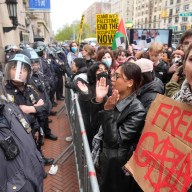 MOVE members are forced from their row home headquarters in 1978 in “Let the Fire Burn.”
MOVE members are forced from their row home headquarters in 1978 in “Let the Fire Burn.”
Credit: Sam Psoras
‘Let the Fire Burn’
Director: Jason Osder
Genre: Documentary
Rating: NR
4 (out of 5) Globes
Apart from drawing light to an unspeakably horrific event that has long loomed over the city in which it occurred, “Let the Fire Burn” — about the 1985 MOVE bombing in Philadelphia that left 11 people dead, most of them children, and reduced blocks to rubble — is an example of an expository documentary that thinks outside the box. Films like “Senna” and “Chicago 10” have struggled to get docs away from the mere “talking heads and archival footage” approach and more toward something that’s, for lack of a better word, “cinematic.”
And “Let the Fire Burn” is incredibly cinematic. Where “Senna” kept the retrospective interviews but excluded the actual footage of the heads talking, Jason Osder’s film even loses the interviews. Apart from the score and the very occasional basic intertitle to help us along, all we see and hear is footage from the day. We’re immersed in the present of this world, and reminded of two things: MOVE (not an acronym, alas) were both once more of a hippie commune as well as a lot more of a nuisance than their martyr-like post-tragedy rep would have it.
Osder cleverly wraps this around the post-event hearings, when city officials tried to get a handle on how a forced eviction from their West Philly row home headquarters led to unimaginable destruction via borderline absurdist incompetence. There’s no way the absolute truth will ever be definitively known, but even then it appears the police started the fight. (MOVE may have been armed, but their heavier artillery was not loaded.) Back and forth the film goes, from calm but stunned investigators grilling the police and mayor Wilson Goode, who OK’d the move to drop a small bomb on their roof, then watched from his office on TV as the fires spread and people died.
The lack of retrospection may grate some, and occasionally the decision to keep almost entirely to existing footage means a lack of a worthwhile angle, or even facts. MOVE’s evolution from urban collective to something more dangerous — or was that just a misconception? — is one thing boring talking heads could make clearer. And though Osder tries not to editorialize, the mournful score — which even plucks from reliable downer composer Erik Satie — quickly becomes a bit much. But as ever, those interested in learning more always have the Internet. “Let the Fire Burn” has something of equal value: the events themselves put vividly back into the present.

















